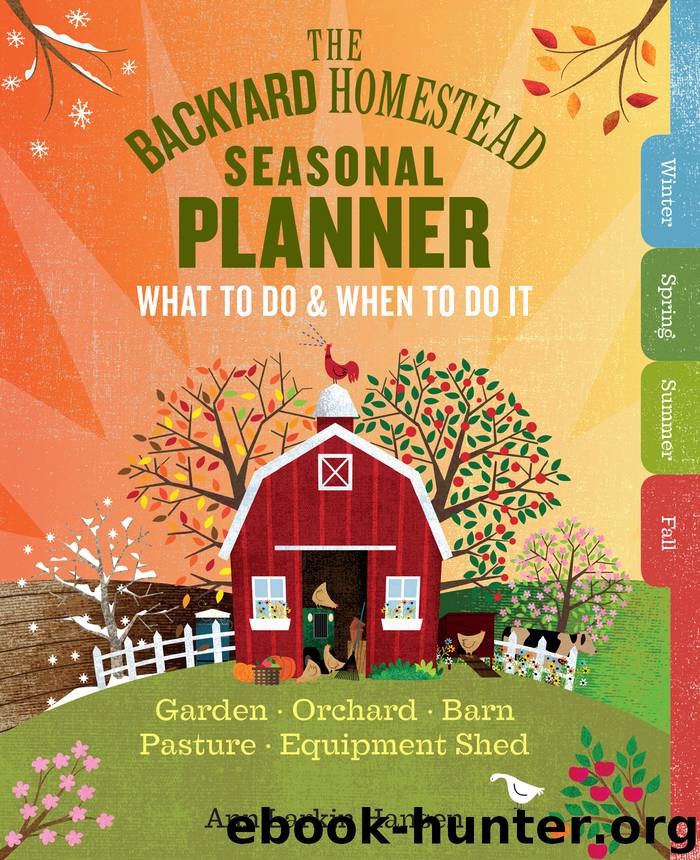The Backyard Homestead Seasonal Planner by Ann Larkin Hansen

Author:Ann Larkin Hansen
Language: eng
Format: epub
Tags: seasonal farm chores;farm chore schedule;when to plant cover crops;crop rotation;when to harvest honey;beehive maintenance schedule;when to vaccinate livestock;making hay;pasture management;soil improvement;when to start seeds;how often should you clean your chicken coop;rodent control;when to prune fruit trees;when to tap maple trees
Publisher: Storey Publishing, LLC
Published: 2017-08-10T20:35:06+00:00
To make small square hay bales, you need a crew and weather-tight storage, but the result can be very high-quality hay.
It usually takes three to five days to make hay: a day to cut, a day or two to dry, and a day or two to rake and bale or fork onto a wagon and place under cover. Ideally, the weather will be dry this entire time, but if you can’t avoid rain entirely, at least wait to rake and bale the hay until it is dry. When you can pick up a hank and it feels dry but isn’t so dry it crumbles, that’s the time to rake. Wet hay raked into a windrow will not dry reliably and will at best mold in patches, at worst heat and start a fire. Once the hay is raked into windrows, you don’t want to bale it until it’s crackly-dry. This may take an hour in really hot, dry weather or a day if it’s quite humid. Don’t just test the tops of the windrows; kick them over here and there and feel the hay underneath, too.
You can cut hay with a scythe or mechanical mower — anything from a sickle bar cutter to a haybine to a discbine and variations on these basic implements. Generally, you first cut several rows around the outside of the field, then cut up and down the interior of the field, working in blocks.
Rake the outside rows so they’re not so close to the fence or field edge that the baler can’t pick them up, and not so close to the interior rows that you won’t be able to turn the tractor and rake without disturbing the edge rows. How exactly you do this will depend on your equipment. Small walk-behind equipment can turn in a small area; our tractor with the V-rake cannot. If you’re making small square bales or picking up the loose hay, rake each cut row into its own windrow. For a round baler or large square baler, you can rake several rows together.
Hay can be gathered with a pitchfork and flatbed trailer or even a pickup truck, a square baler and hay wagon, or a round baler. Large square balers are generally beyond the needs or budget of a small farm, and the bales are difficult to move without a skid-steer loader and big flatbed trailer. We originally made small squares, then in subsequent years we paid a custom operator to round bale for us after I’d done the mowing and raking, and now we use a round baler we bought at an auction. This has made haying much quicker than it used to be, but it’s also a significant investment in equipment — one that we couldn’t have afforded to make except over many years.
Hay that’s gathered loose or made into small square bales should be stored under cover: either in a barn hayloft or in a shed with a floor that won’t transmit moisture. This means putting a solid plastic tarp or spaced boards under the bottom layer of hay.
Download
This site does not store any files on its server. We only index and link to content provided by other sites. Please contact the content providers to delete copyright contents if any and email us, we'll remove relevant links or contents immediately.
Compact Houses by Gerald Rowan(1831)
Food Storage for Self-Sufficiency and Survival by Angela Paskett(1668)
Backyard Chickens Beyond the Basics by Pam Freeman(1615)
The Magickal Family by Monica Crosson(1417)
100 Skills You'll Need for the End of the World (as We Know It) by Ana Maria Spagna(1409)
Lagom by Niki Brantmark(1378)
Pure Charcuterie: The Craft & Poetry of Curing Meat at Home by Meredith Leigh(1363)
Living Off the Grid by David Black(1361)
The Unsettlers by Mark Sundeen(1339)
Mother Earth News Almanac by Mother Earth News(1260)
A Life Less Throwaway by Tara Button(1195)
The Backyard Homestead Guide to Raising Farm Animals: Choose the Best Breeds for Small-Space Farming, Produce Your Own Grass-Fed Meat, Gather Fresh ... Rabbits, Goats, Sheep, Pigs, Cattle, & Bees by Gail Damerow(1187)
The Backyard Homestead Seasonal Planner by Ann Larkin Hansen(1142)
Backyard Foraging by Ellen Zachos(1141)
Fruit Trees, Berries & Nuts by Kim Pezza(1134)
The Sustainable Asian House by Paul McGillick(1114)
Building Today's Green Home: Practical, Cost-Effective and Eco-Responsible Homebuilding (Popular Woodworking) by Smith Art(1060)
Life Without Plastic by Chantal Plamondon & Jay Sinha(1030)
Making Transparent Soap by Catherine Failor(1015)
